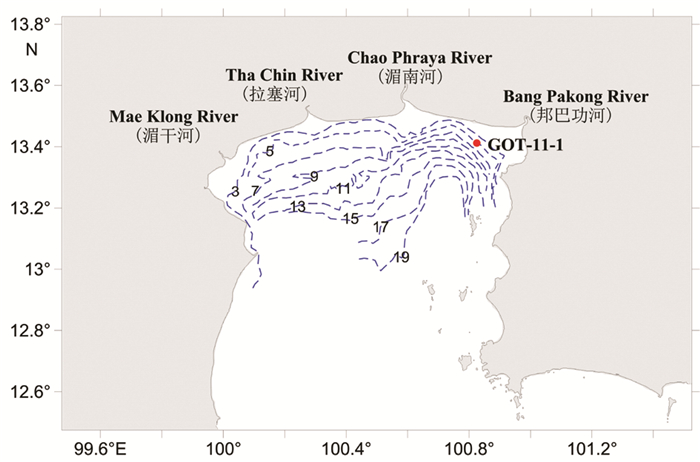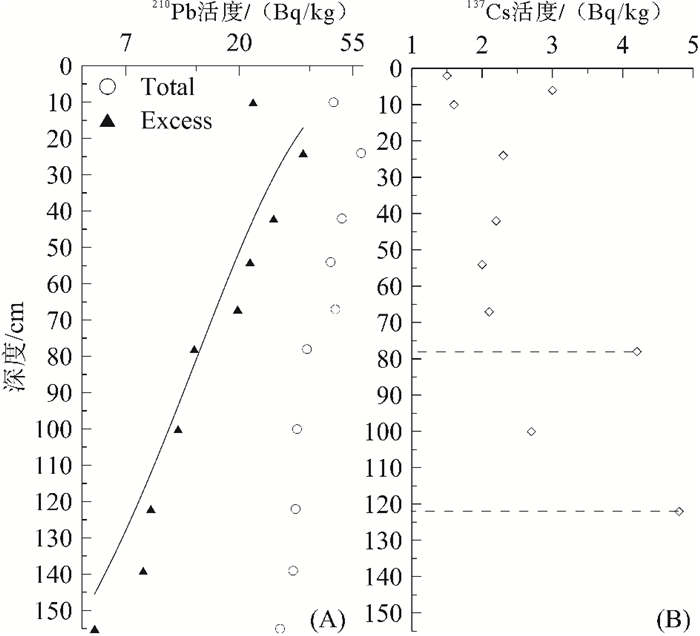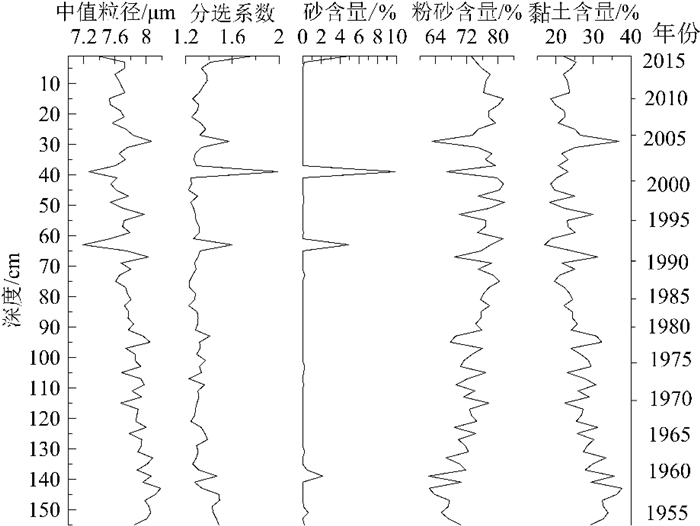Variation trend and contamination source of heavy metals in sediments from estuary area of Bangkok Bay in the past century
-
摘要:
2015年7月在泰国曼谷湾邦巴功河河口采集了1根1.5m长的沉积物柱样,分析了样品中重金属元素(Cd、Pb、Co、Ni、Cu、Cr、Zn)含量,进行了粒度和210Pb、137Cs活度测试,使用地累积指数、元素污染指数和潜在生态风险参数对重金属污染情况进行评级, 并结合实际情况对污染来源进行了推断。结果表明:沉积柱状样210Pb、137Cs活度测试结果计算获得的沉积速率约为2.3cm/a,沉积物柱状样记录了1948—2015年的沉积情况。7种重金属元素含量均值分别为0.11、29.60、19.78、44.18、28.99、80.93、99.01 mg/kg。重金属含量较20世纪都有所增长,Cd、Zn、Pb、Cr在整段沉积时间框架内增长明显。元素富集程度顺序为Cd>Zn>Pb>Cr>Cu>Ni>Co, Cd元素污染程度最为严重,Pb、Cu和Zn为偏中度污染,Cr、Ni和Co为轻度污染。单一重金属生态风险系数Eri评级顺序为Cd>Pb>Cu>Ni>Co>Cr>Zn。其中Cd为很强至极强生态危害,Pb为轻微至中等生态危害。Cd、Zn、Cu和Pb元素没有超出泰国沉积物环境质量基准规定的效应区间低值,Ni超出效应区间低值,但没有超过效应区间中值。重金属元素与Al较差的相关性表明重金属元素主要是非自然来源,Cd、Cu、Zn可能源于金属冶炼和交通,此外, Cd还可能存在其他未知工业污染来源,受人类活动影响较大。Cr可能源于纺织业发展。1990年之后较1990年之前重金属元素之间的相关性更差,指示1990年之后相比1990年之前重金属污染来源更复杂。
Abstract:A 1.5-meter long sediment core was collected from the estuary of Bang Pakong River, Bangkok Bay, in July 2015. Calculated with 210Pb and 137Cs, the sedimentation rate is 2.3cm/a. It means that the sediment has been deposited in the year from 1948 to 2015. Heavy metal element (Cd, Pb, Co, Ni, Cu, Cr and Zn) concentrations, measured by ICP-MS, are 0.11, 29.60, 19.78, 44.18, 28.99, 80.93 and 99.01 mg/kg, respectively. Amounts of Cd, Zn, Pb and Cr increased significantly during the period. The degree of heavy metal pollution ranks in an order of Cd>Zn>Pb>Cr>Cu>Ni>Co. Calculated geo-accumulation indices demonstrate that the sediment are moderately polluted by Cd, and slightly by Pb, Co, Ni, Cu, Cr and Zn. The potential ecological risk indexes of single element(Eri) are ranked in an order of Cd > Pb > Cu > Ni > Co > Cr > Zn. Ecological risk evaluation of heavy metals suggests that Cd is high to very high in ecological risk, while Pb is low to moderate. The concentrations of Cd, Zn, Cu and Pb in the sediments are lower than the effects range low(ERL), and the concentrations of Ni have exceeded the effects range low(ERL), but below the effects range median(ERM). Cd, Cu and Zn may derive from metallurgical industry and transportation. Cd has an unknown source of pollution, strongly influenced by human activities. The anomaly high Cr may be from textile industry. Inter-elemental correlation of heavy metals before the year of 1990 was worse than that after 1990, indicating that there may be more complex sources of heavy metal pollution after the year of 1990.
-
Key words:
- sediment /
- heavy metals /
- grain size /
- Bangkok Bay
-

-
表 1 沉积物中重金属元素含量(mg/kg)和污染累积
Table 1. Concentration(mg/kg) and pollution accumulation indices of heavy metals in the sediment
元素及元素比值 含量范围(均值) Igeo范围(均值) Eri ERL ERM Cd 0.07~0.19(0.11) 1.64~3.08(2.29) 140.00~378.00(210.27) 1.2 9.6 Co 18.10~20.96(19.78) 0.30~0.51(0.43) 9.23~10.69(10.09) - - Cu 26.15~32.38(28.99) 1.11~1.41(1.25) 16.14~19.99(17.90) 34 270 Pb 26.13~60.83(29.60) 1.42~2.64(1.60) 20.10~46.79(22.77) 46.7 218 Zn 82.79~108.78(99.01) 1.70~2.09(1.96) 4.87~6.40(5.82) 150 410 Cr 75.83~89.77(80.93) 1.34~1.58(1.43) 7.58~8.98(8.09) - - Ni 41.77~48.54(44.18) 0.41~0.62(0.49) 9.94~11.56(10.52) 20.9 51.6 表 2 中国主要河口及近海沉积物重金属元素含量
Table 2. Heavy metal concentration(mg/kg) in sediments from the main estuaries of China
mg/kg Zn Cr Co Ni Cu Cd Pb 黄河口新生湿地沉积物岩心(平均值)[13] 80.84 79.45 14.25 34.92 27.06 0.26 26.92 渤海西部表层沉积物(平均值)[14] 75.7 68.9 — 30.3 25.5 0.14 22.3 长江口表层沉积物(平均值)[15] — — — — 26.1 0.13 23 长江口表层沉积物(平均值)[16] 95 40 — — 26 0.074 64 珠江口海域[17] 130.4 86.3 — — 39.4 0.2 53.3 南海陆架[18] 54.4 39.3 — — 7.43 0.18 15.6 注:“—”表示研究中没有对应值 表 3 曼谷湾沉积物中金属元素含量(mg/kg)之间和沉积物各粒级组分(%)的相关性分析
Table 3. Correlation of heavy metals with sand, silt and clay fractions of the sediment from Bangkok Bay
Zn Cr Co Ni Cu Cd Pb Al2O3 砂 粉砂 黏土 Zn 1.000 Cr -0.103 1.000 Co 0.499** 0.134 1.000 Ni -0.037 0.538** 0.448** 1.000 Cu 0.874** 0.016 0.297 -0.080 1.000 Cd 0.517** 0.027 -0.165 -0.304 0.645** 1.000 Pb 0.141 -0.212 -0.186 -0.300 0.151 0.121 1.000 Al2O3 -0.238 0.477** 0.064 0.037 -0.172 -0.036 -0.103 1.000 砂 0.069 -0.135 -0.299 -0.333* 0.168 0.187 0.933** -0.024 1.000 粉砂 0.759** -0.162 0.461** -0.119 0.706** 0.422** 0.011 -0.240 -0.054 1.000 黏土 -0.766** 0.185 -0.404* 0.178 -0.732** -0.453** -0.178 0.242 -0.126 -0.984** 1.000 **:相关性的显著性在0.01水平(双尾检验)
*:相关性的显著性在0.05水平(双尾检验)表 4 1948—1990年曼谷湾沉积物中金属元素含量(mg/kg)之间和沉积物各粒级组分(%)的相关性分析
Table 4. Correlations of heavy metals and sand, silt, clay fractions of the sediment from Bangkok Bay (1948—1990)
Zn Cr Co Ni Cu Cd Pb Al2O3 砂 粉砂 黏土 Zn 1.000 Cr -0.088 1.000 Co 0.864** -0.048 1.000 Ni 0.266 0.688** 0.362 1.000 Cu 0.784** 0.078 0.739** 0.302 1.000 Cd -0.390 0.251 -0.422 -0.152 -0.469* 1.000 Pb 0.526* -0.293 0.319 -0.073 0.273 -0.025 1.000 Al2O3 -0.196 0.282 -0.026 -0.081 -0.088 0.275 -0.350 1.000 砂 -0.280 -0.059 -0.369 -0.274 -0.196 -0.240 0.095 -0.107 1.000 粉砂 0.741** -0.399 0.629** -0.101 0.609** -0.312 0.547* -0.251 -0.025 1.000 黏土 -0.733** 0.400 -0.618** 0.109 -0.603** 0.318 -0.550* 0.253 -0.004 -1.000** 1.000 **:相关性的显著性在0.01水平(双尾检验)
*:相关性的显著性在0.05水平(双尾检验)表 5 1990—2015年曼谷湾沉积物中金属元素含量(mg/kg)之间和沉积物各粒级组分(%)的相关性分析
Table 5. Correlations of heavy metals and sand, silt, clay fractions of the sediment from Bangkok Bay (1990-2015)
Zn Cr Co Ni Cu Cd Pb Al2O3 砂 粉砂 黏土 Zn 1.000 Cr -0.324 1.000 Co -0.065 0.381 1.000 Ni -0.024 0.311 0.794** 1.000 Cu 0.402 -0.012 -0.426 -0.076 1.000 Cd 0.120 -0.011 -0.507* -0.351 0.433 1.000 Pb -0.130 -0.221 -0.462 -0.553* 0.120 0.097 1.000 Al2O3 -0.230 0.851** 0.300 0.230 -0.112 0.055 0.015 1.000 砂 -0.164 -0.200 -0.471 -0.554* 0.119 0.108 0.995** 0.018 1.000 粉砂 -0.001 0.108 0.228 0.334 0.037 0.002 -0.376 -0.076 -0.360 1.000 黏土 0.070 -0.032 -0.047 -0.126 -0.089 -0.047 -0.014 0.074 -0.033 -0.921** 1.000 **:相关性的显著性在0.01水平(双尾检验)
*:相关性的显著性在0.05水平(双尾检验) -
[1] Tomczak M, Godfrey J S. Regional Oceanography: An Introduction[M]. Elsevier, 2013.
[2] Wattayakorn G. Petroleum pollution in the Gulf of Thailand: A historical review[J]. Coastal Marine Science, 2012, 35(1):234-245.
[3] Hu L M, Shi X F, Bai Y Z, et al. Distribution, input pathway and mass inventory of black carbon in sediments of the Gulf of Thailand, SE Asia[J]. Estuarine Coastal & Shelf Science, 2016, 170:10-19. http://www.wanfangdata.com.cn/details/detail.do?_type=perio&id=6073826519d1b01c07126281253f90a7
[4] Polprasert C. Heavy metal pollution in the Chao Phraya River estuary, Thailand[J]. Water Research, 1982, 16(6): 775-784. doi: 10.1016/0043-1354(82)90004-5
[5] Hungspreugs M, Yuangthong C. A history of metal pollution in the Upper Gulf of Thailand [J]. Marine Pollution Bulletin, 1983, 14(12):465-469. doi: 10.1016/0025-326X(83)90047-4
[6] Thaicharoen C, Gupta A D, Vongvisessomjai S. Implications of effluent discharge from a proposed wastewater treatment plant on coastal water quality in the Upper Gulf of Thailand[J]. Water International, 2007, 32(4):644-660. doi: 10.1080/02508060.2007.9709695
[7] Cheevaporn V. History of heavy metal contamination in Bang Pakong River Estuary, Thailand[J]. Journal of Theence Society of Thailand, 1995, 20(1):9-22.
[8] Censi P, Spoto S E, Saiano F, et al. Heavy metals in coastal water systems. A case study from the northwestern Gulf of Thailand[J]. Chemosphere, 2006, 64(7):1167-76. doi: 10.1016/j.chemosphere.2005.11.008
[9] Pradit S, Shazili N A M, Towatana P, et al. Trace metals, grain size and organic matter in sediment from a coastal area of Thailand and Malaysia[J]. Aquatic Ecosystem Health & Management, 2016, 19(4):345-354. http://cn.bing.com/academic/profile?id=779d095d2afe288ce07e8f27cb13ed63&encoded=0&v=paper_preview&mkt=zh-cn
[10] 乔淑卿, 石学法, 高晶晶, 等.曼谷湾沉积物重金属元素的富集效应与生物有效性[J].中国环境科学, 2015, 35(11):3445-3451. doi: 10.3969/j.issn.1000-6923.2015.11.032
QIAO Shuqing, SHI Xuefa, GAO Jingjing, et al. Enrichment and bioavailability of heavy metals in sediments of the Bangkok Bay[J].China Environmental Science, 2015, 35(11):3445-3451. doi: 10.3969/j.issn.1000-6923.2015.11.032
[11] Liu S F, Shi X F, Yang G, et al. Distribution of major and trace elements in surface sediments of the western Gulf of Thailand: Implications to modern sedimentation[J]. Continental Shelf Research, 2016, 117:81-91. doi: 10.1016/j.csr.2016.02.002
[12] Windom H L, Silpipat S, Chanpongsang A, et al. Trace metal composition of and accumulation rates of sediments in the Upper Gulf of Thailand[J]. Estuarine Coastal & Shelf Science, 1984, 19(2):133-142. http://d.old.wanfangdata.com.cn/NSTLQK/10.1016-0272-7714(84)90060-X/
[13] 王启栋, 宋金明, 李学刚, 等.黄河口新生湿地沉积物中的金属元素及其环境指示意义[J].海洋科学集刊, 2016. http://d.old.wanfangdata.com.cn/Periodical/hykjjk201601016
WANG Qidong, SONG Jinming, LI Xuegang, et al.Metal elements in the sediment of the newly created wetlands of Yellow River Estuary and their environmental significances[J].Studia Marina Sinica, 2016. http://d.old.wanfangdata.com.cn/Periodical/hykjjk201601016
[14] 蓝先洪, 顾兆峰, 密蓓蓓, 等.渤海西部表层沉积物中重金属的环境地球化学特征[J].现代地质, 2017, 31(2):367-373. doi: 10.3969/j.issn.1000-8527.2017.02.015
LAN Xianhong, GU Zhaofeng, MI Beibei, et al.Environmental geochemical characteristics of heavy metals in surface sediments from the western Bohai Sea[J].Geoscience, 2017, 31(2):367-373. doi: 10.3969/j.issn.1000-8527.2017.02.015
[15] 赵敏, 张丽旭.长江口海域表层沉积物环境质量的综合评价[J].长江流域资源与环境, 2016, 25(2):284-291. http://www.wanfangdata.com.cn/details/detail.do?_type=perio&id=cjlyzyyhj201602014
ZHAO Min, ZHANG Lixu.The comprehensive assessing of surface sediments environmental quality in Changjiang estuary inshore[J].Resources and Environment in the Yangtze Basin, 2016, 25(2):284-291. http://www.wanfangdata.com.cn/details/detail.do?_type=perio&id=cjlyzyyhj201602014
[16] 薛彬, 郑刚, 李铁军, 等.长江河口外海柱状沉积物重金属来源判别[J].广州化工, 2016, 44(20):119-120. doi: 10.3969/j.issn.1001-9677.2016.20.045
XUE Bin, ZHENG Gang, LI Tiejun, et al. Sources identification of heavy metals of Changjiang estuary[J].Guangzhou Chemical Industry, 2016, 44(20):119-120. doi: 10.3969/j.issn.1001-9677.2016.20.045
[17] 黄向青, 梁开, 刘雄.珠江口表层沉积物有害重金属分布及评价[J].海洋湖沼通报, 2006(3):27-36. doi: 10.3969/j.issn.1003-6482.2006.03.005
HUANG Xiangqing, LIANG Kai, LIU Xiong.The distribution and assessment of heavy metals in surficial sediments in the Pearl River estuary[J].Transactions of Oceanology and Limnology, 2006(3):27-36. doi: 10.3969/j.issn.1003-6482.2006.03.005
[18] 张远辉, 杜俊民.南海表层沉积物中主要污染物的环境背景值[J].海洋学报(中文版), 2005, 27(4):161-166. doi: 10.3321/j.issn:0253-4193.2005.04.022
ZHANG Yuanhui, DU Junmin.Background values of pollutants in sediments of the South China Sea[J].Acta Oceanologica Sinica, 2005, 27(4):161-166. doi: 10.3321/j.issn:0253-4193.2005.04.022
[19] Gao S, Luo T C, Zhang B R, et al. Chemical composition of the continental crust as revealed by studies in East China[J]. Geochimica Et Cosmochimica Acta, 1998, 62(11):1959-1975. doi: 10.1016/S0016-7037(98)00121-5
[20] Alhashemi A H, Karbassi A R, Kiabi B H, et al. Accumulation and bioaccessibility of trace elements in wetland sediments[J]. African Journal of Biotechnology, 2011, 10(9):1625-1636. http://www.wanfangdata.com.cn/details/detail.do?_type=perio&id=Open J-Gate000003938199
[21] Zalewska T, Woroń J, Danowska B, et al. Temporal changes in Hg, Pb, Cd and Zn environmental concentrations in the southern Baltic Sea sediments dated with 210Pb method [J]. Oceanologia, 2015, 57(1):32-43. doi: 10.1016/j.oceano.2014.06.003
[22] Hakanson L. An ecological risk index for aquatic pollution control.a sedimentological approach[J]. Water Research, 1980, 14(8):975-1001. doi: 10.1016/0043-1354(80)90143-8
[23] 徐方建, 田旭, 刘兆庆, 等.胶州湾潮间带表层沉积物重金属污染评价[J].中国环境科学, 2017, 37(6):2239-2247. doi: 10.3969/j.issn.1000-6923.2017.06.031
XU Fangjian, TIAN Xu, LIU Zhaoqing, et al. Evaluation of heavy metals pollution in surface sediments of the intertidal Jiaozhou Bay, China[J].China Environmental Science, 2017, 37(6):2239-2247. doi: 10.3969/j.issn.1000-6923.2017.06.031
[24] 徐争启, 倪师军, 庹先国, 等.潜在生态危害指数法评价中重金属毒性系数计算[J].环境科学与技术, 2008, 31(2):112-115. doi: 10.3969/j.issn.1003-6504.2008.02.030
XU Zhengqi, NI Shijun, TUO Xianguo, et al.Calculation of heavy metals' toxicity coefficient in the evaluation of potential ecological risk index[J].Environmental Science & Technology, 2008, 31(2):112-115. doi: 10.3969/j.issn.1003-6504.2008.02.030
[25] Thongraar W. Heavy metals contamination in sediments along the eastern coast of the gulf of Thailand[J]. Environment Asia, 2008, 1(1):37-45.
[26] Zaharescu D G, Hooda P S, Soler A P, et al. Trace metals and their source in the catchment of the high altitude Lake Respomuso, Central Pyrenees[J]. Science of the Total Environment, 2009, 407(11):3546-53. doi: 10.1016/j.scitotenv.2009.02.026
[27] Hungspreugs M, Silpipat S, Tonapong C, et al. Heavy metals and polycyclic hydrocarbon compounds in benthic organisms of the Upper Gulf of Thailand [J]. Marine Pollution Bulletin, 1984, 15(6):213-218. doi: 10.1016/0025-326X(84)90289-3
[28] Cheevaporn V, Menasveta P. Water pollution and habitat degradation in the Gulf of Thailand[J]. Marine Pollution Bulletin, 2003, 47(1): 43-51. http://www.wanfangdata.com.cn/details/detail.do?_type=perio&id=fe0ff504e53542d14fbb784067952d5c
[29] Sudsandee S, Tantrakarnapa K, Tharnpoophasiam P, et al. Evaluating health risks posed by heavy metals to humans consuming blood cockles (Anadaragranosa) from the Upper Gulf of Thailand[J]. Environmental Science and Pollution Research, 2017, 24(17): 14605-14615. doi: 10.1007/s11356-017-9014-5
[30] Freije A M. Heavy metal, trace element and petroleum hydrocarbon pollution in the Arabian Gulf: Review[J]. Journal of the Association of Arab Universities for Basic & Applied Sciences, 2015, 17(C):90-100. http://cn.bing.com/academic/profile?id=2d7e9a4706a6ef2f0607cb31315575a7&encoded=0&v=paper_preview&mkt=zh-cn
[31] Hu L M, Shi X F, Qiao S Q, et al. Sources and mass inventory of sedimentary polycyclic aromatic hydrocarbons in the Gulf of Thailand: Implications for pathways and energy structure in SE Asia[J]. Science of the Total Environment, 2016, 575(2017):982-995. http://cn.bing.com/academic/profile?id=25423dcae554ab79b95b044382288668&encoded=0&v=paper_preview&mkt=zh-cn
[32] 陈维东.泰国新的锡冶炼厂[J].中国有色冶金, 1979(4):65. http://www.cnki.com.cn/Article/CJFDTOTAL-YSYL197904012.htm
CHEN Weidong. New tin smelter in Thailand[J].Chian Nonferrous Metallurcy, 1979(4):65. http://www.cnki.com.cn/Article/CJFDTOTAL-YSYL197904012.htm
[33] 陈汉春.泰国铜厂考察后记[J].铜业工程, 2004(1):6-8. doi: 10.3969/j.issn.1009-3842.2004.01.002
CHEN Hanchun. Review on the visity in Thailand copper[J].Copper Engineering, 2004(1):6-8. doi: 10.3969/j.issn.1009-3842.2004.01.002
[34] 李瑞霞.泰国汽车业的发展与展望[J].东南亚南亚研究, 2004(4):31-35. doi: 10.3969/j.issn.1674-6392.2004.04.006
LI Ruixia.Development and prospect of Thai-land automobile industry[J].Southeast Asian and South Asian Studies, 2004(4):31-35. doi: 10.3969/j.issn.1674-6392.2004.04.006
[35] 汤克勇.铬的污染源及其危害[J].皮革科学与工程, 1997(1):33-37. http://www.wanfangdata.com.cn/details/detail.do?_type=perio&id=QK199700423479
TANG Keyong. Sources and harmfulness of chromium pollution[J]. Leather Science and Engineering, 1997(1):33-37. http://www.wanfangdata.com.cn/details/detail.do?_type=perio&id=QK199700423479
[36] 司伟.饱受金融危机煎熬的泰国纺织业[J].现代丝绸科学与技术, 1998(5):40+19. http://www.wanfangdata.com.cn/details/detail.do?_type=perio&id=QK199800150212
SI Wei.Thai textile industry suffering from financial crisis[J].Modern Silk Science & Technology, 1998(5):40+19. http://www.wanfangdata.com.cn/details/detail.do?_type=perio&id=QK199800150212
[37] 佚名.泰国纺织工业的设备与产量[J].上海纺织科技, 1974(3):15. http://www.cnki.com.cn/Article/CJFDTOTAL-SFXK197403030.htm
Nameless.Equipment and output of Thailand textile industry[J].Shanghai Textile Science & Technology, 1974(3):15. http://www.cnki.com.cn/Article/CJFDTOTAL-SFXK197403030.htm
-




 下载:
下载:


